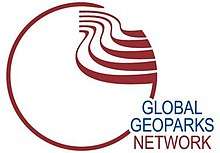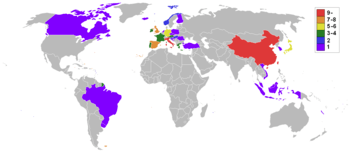Global Geoparks Network

The Global Geoparks Network (GGN) (also known as the Global Network of National Geoparks) is a UNESCO assisted network established in 1998. Managed under the body’s Ecological and Earth Sciences Division, the GGN seeks the promotion and conservation of the planet’s geological heritage, as well as encourages the sustainable research and development by the concerned communities.[1][2][3]
The network

The international network seeks the membership geoparks—geographical areas where geological heritage is the focus of local protection, education and development.
A set of criteria as established by UNESCO must first be met for a geopark, as nominated by the corresponding government, to be included in the GGN:
- the existence of a management plan designed to foster socio-economic development that is sustainable (most likely to be based on agritourism and geotourism);
- demonstrate methods for conserving and enhancing geological heritage and provide means for teaching geoscientific disciplines and broader environmental issues;
- joint-proposals submitted by public authorities, local communities and private interests acting together, which demonstrate the best practices with respect to Earth heritage conservation and its integration into sustainable development strategies
Criteria satisfaction is evaluated during biennial meetings (every even year) by the Geoparks Committee, known as the International Conference on Geoparks, which is also in charge with the periodic review of projects related to geological awareness. The first members of the GGN were named during the first conference in 2004, and it has continued to grow since then:
| Session | Year | Site | Date |
|---|---|---|---|
| 1st | 2004 | Beijing, China | June 27–July 7 |
| 2nd | 2006 | Belfast, United Kingdom | September 17–21 |
| 3rd | 2008 | Osnabrück, Germany | June 22–26 |
| 4th | 2010 | Langkawi, Malaysia | April 12–16 |
| 5th | 2012 | Unzen Volcanic Area Geopark (Shimabara, Japan) | May 12–15 |
| 6th | 2014 | Stonehammer Geopark (Saint John, New Brunswick, Canada) | September 19–22 |
The GGN works in close synergy with another project under UNESCO’s Ecological and Earth Sciences Division—the Man and Biosphere (MAB) World Network of Biosphere Reserves—to come up with and establish different means of sustainable development in promoting the local communities’ relationship with the natural environment.
As of April 2018, 140 geoparks from 38 countries, mostly in Europe and east Asia, have been included in the GGN.[4]
See also
References
External links
| Wikimedia Commons has media related to Geoparks. |
- UNESCO list of Global Geoparks — Global Geoparks Network members
- International Union of Geological Sciences — Minutes of the 46th Executive Committee Meeting, Cairo, Egypt, January 26–30, 2000.
- International Union of Geological Sciences — 45th Executive Committee Meeting, Vienna, Austria, January 26–30, 1998.